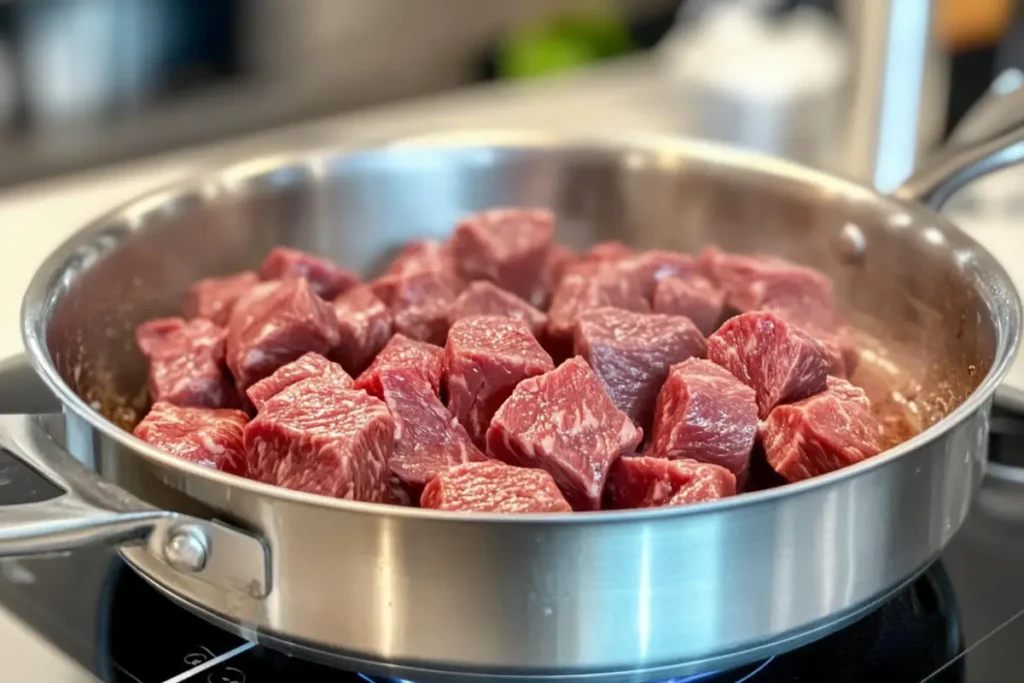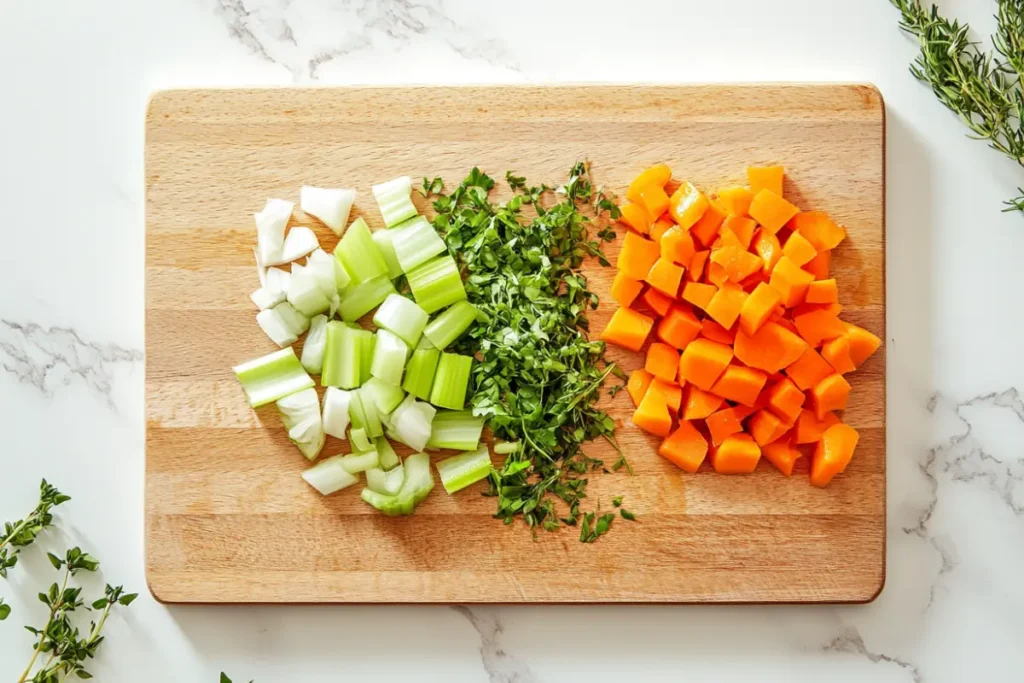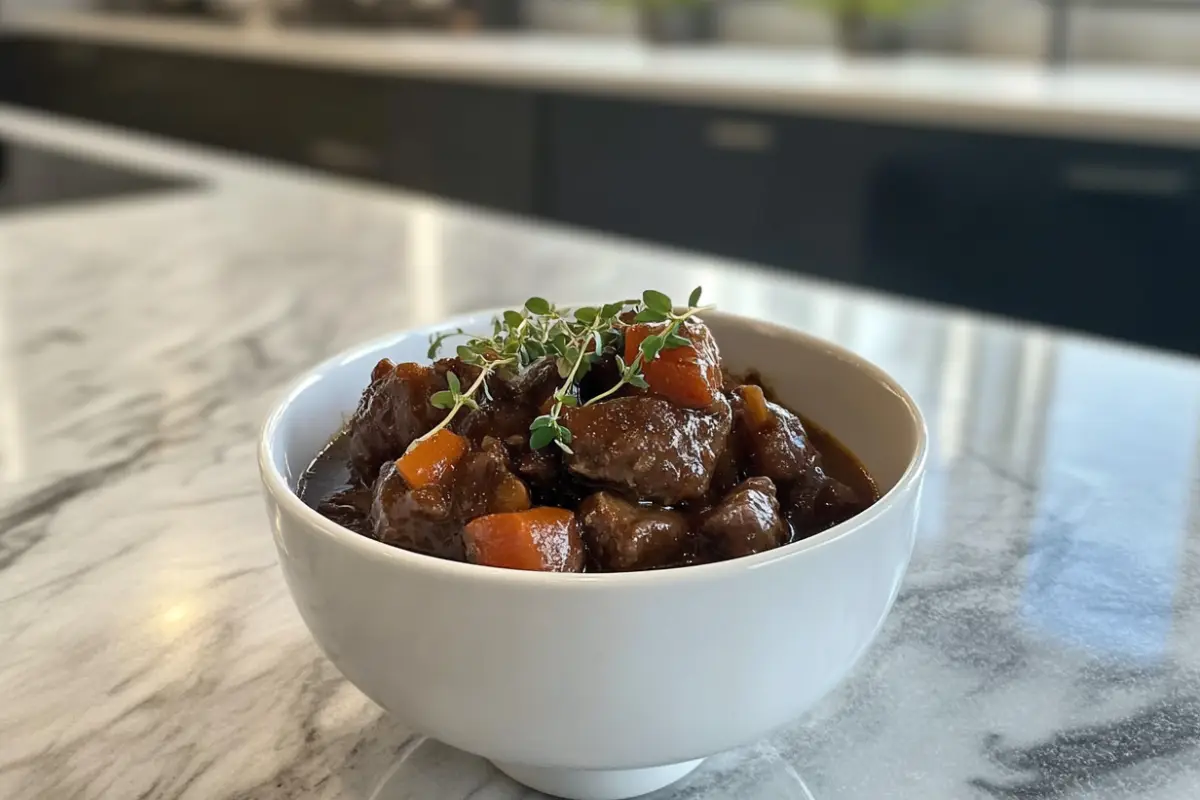Last Updated on March 25, 2025 by Souhail
There’s something undeniably comforting about a pot of stew rich, hearty, and full of flavor. But making a truly great stew isn’t just about tossing ingredients into a pot and hoping for the best. So, what is the secret to a good stew? The answer lies in mastering key techniques, choosing the right ingredients, and understanding how to build depth of flavor.
In this guide, I’ll break down the essential secrets to making a stew that will wow your family and friends every time. Whether you’re a seasoned home cook or a beginner, these tips will ensure that every spoonful of your stew is rich, thick, and full of complex, satisfying flavors.
Table of contents
- 1. Browning the Meat (Or Vegetables) First: The Flavor Foundation
- 2. Use the Right Cut of Meat for the Best Texture
- 3. Don’t Rush the Cooking Process: Time Equals Flavor
- 4. Balance the Flavors: Salt, Acid, and Sweetness
- 5. Use Quality Stock or Broth
- 6. Thicken Your Stew the Right Way
- 7. Let the Stew Rest Before Serving
- FAQs: Common Questions About Making the Perfect Stew
- Troubleshooting Tips: Fixing Common Stew Mistakes
- The Secret to a Good Stew: Final Thoughts and Recipe Inspiration
1. Browning the Meat (Or Vegetables) First: The Flavor Foundation
One of the most important secrets to a good stew is starting with a strong flavor base. Browning your meat or vegetables before simmering creates a deep, caramelized layer of flavor that forms the backbone of your dish. This step is often referred to as the Maillard reaction, where the natural sugars in the meat or vegetables break down and create that beautiful golden crust.

Here’s why this step is crucial:
- Adds depth and complexity to your stew.
- Prevents blandness by locking in flavor.
- Improves texture of the meat or vegetables.
Pro Tip: When browning meat, it’s important to remember not to overcrowd the pan. Otherwise, the meat will steam instead of sear, which can result in a less flavorful stew. To avoid this, brown the meat in batches if needed, and furthermore, always scrape up the flavorful bits (fond) from the bottom of the pan, as this step ensures you capture all those rich, caramelized flavors.
2. Use the Right Cut of Meat for the Best Texture
If you’re making a meat-based stew, the cut of meat you choose can make or break the dish. The secret to this good stew is to use tougher cuts of meat that break down during long, slow cooking. These cuts, rich in connective tissue and fat, transform into tender, flavorful bites when cooked low and slow.
Best cuts of meat for stew:
- Beef chuck roast (for classic beef stew)
- Oxtail (for a rich, gelatinous stew)
- Lamb shoulder (for hearty lamb stew)
- Pork shoulder (for a flavorful pork stew)
Avoid lean cuts of meat like sirloin or chicken breast, which can become dry and tough when simmered for long periods.
Vegetarian Tip: Even in vegetarian stews, you need hearty ingredients. Use root vegetables, mushrooms, or lentils to achieve a rich, meaty texture.
3. Don’t Rush the Cooking Process: Time Equals Flavor
Patience is a virtue when it comes to making a good stew. One of the biggest secrets is allowing the stew to simmer slowly and gently for several hours. This gives the flavors time to meld together and the tougher cuts of meat time to tenderize.
Why does slow cooking matter?
- It breaks down tough connective tissues in meat.
- It allows flavors to develop fully.
- It ensures a rich, thick broth.
Pro Tip: Use a heavy-bottomed pot like a Dutch oven to distribute heat evenly and prevent scorching. And remember, low and slow is the way to go.
4. Balance the Flavors: Salt, Acid, and Sweetness
A stew should never be one-dimensional. A truly great stew has a balance of savory, salty, acidic, and even slightly sweet notes.
Here’s how to achieve that balance:
- Salt brings out the flavors of the ingredients.
- Acid (like a splash of wine, vinegar, or tomatoes) brightens the dish and cuts through the richness.
- Sweetness (from carrots, onions, or a touch of sugar) adds depth and rounds out the flavors.

Secret Tip: Adding a splash of vinegar, lemon juice, or even a bit of wine at the end of cooking can elevate your stew and prevent it from tasting too heavy.
5. Use Quality Stock or Broth
The liquid base of your stew is just as important as the ingredients you add. The secret to a flavorful stew is using a rich, homemade stock or high-quality store-bought broth. Water can dilute the flavors, so always opt for a flavorful liquid.
Best liquids to use in a stew:
- Beef, chicken, or vegetable stock
- Wine (for added depth)
- Beer (great for beef stews)
- Tomato-based liquids
Pro Tip: If using store-bought broth, choose low-sodium versions so you can control the salt levels.
6. Thicken Your Stew the Right Way
A watery stew is a major disappointment. To achieve the perfect thick, velvety texture, you need to thicken your stew properly. Here are some secrets to getting it just right:
- Flour or cornstarch slurry: Mix flour or cornstarch with cold water and stir it into the stew to thicken.
- Mashed vegetables: Puree a portion of the cooked vegetables and stir them back into the pot.
- Reduction: Let the stew simmer uncovered for the last 30 minutes to reduce and thicken naturally.
Secret Tip: Avoid adding too much flour or cornstarch at once, it can make your stew gummy. Add it gradually and stir well.
7. Let the Stew Rest Before Serving
Here’s a secret to a good stew that many cooks often overlook: in fact, stews taste even better the next day. By letting the stew rest for a few hours (or overnight), you give it time for the flavors to deepen and meld together. As a result, the dish becomes richer, more balanced, and more satisfying when reheated. Therefore, if you have the time, consider making your stew a day ahead for the best possible flavor.
Why resting helps:
- Flavors become more concentrated.
- The meat absorbs more of the liquid.
- The stew thickens as it cools.
Pro Tip: If possible, make your stew a day ahead and reheat it before serving for the best results.
FAQs: Common Questions About Making the Perfect Stew
You may have skipped flavor-building steps. Season as you go, use aromatics, and add umami-rich ingredients like soy or Worcestershire sauce. A splash of vinegar or lemon juice at the end can brighten flavors.
Use a flour or cornstarch slurry, mash vegetables, or let the stew simmer uncovered to reduce excess liquid. Avoid adding too much thickener at once.
Yes! Use hearty ingredients like mushrooms, root vegetables, and lentils. Boost flavor with soy sauce, miso paste, or dried mushrooms for umami depth.
Most stews need at least 2 hours to develop deep flavors. Tough cuts of meat require low and slow cooking to become tender. For vegetable stews, 45 minutes to 1 hour is enough. And here is an other secret to get a flavorful stew.
Cool the stew and store it in an airtight container in the fridge for up to 4 days. For longer storage, freeze it for up to 3 months. Reheat gently and add a splash of water or broth if needed.
Yes, but brown the meat first for better flavor. Use less liquid as slow cookers retain moisture. Cook on low for 6-8 hours to achieve tender, flavorful results.
Troubleshooting Tips: Fixing Common Stew Mistakes
Even experienced cooks can run into issues when making stew. Here’s how to solve some of the most common problems.
| Problem | Cause | Solution |
|---|---|---|
| The meat is tough | The meat hasn’t cooked long enough | Continue simmering the stew for another 30-60 minutes. Use low heat to allow the tough cuts to break down and become tender. |
| The stew is too salty | Too much salt added during cooking | – Add a potato to absorb excess salt. – Add more liquid (broth or water) to dilute the saltiness. – Stir in sugar, cream, or unsalted butter. |
| The stew is greasy | The meat is too fatty, or fat hasn’t been skimmed | – Skim excess fat from the surface using a spoon. – Use a fat separator. – Chill the stew to solidify the fat, then remove the hardened layer. |
| The stew is watery | Too much liquid added, or no thickening agent used | – Thicken with a flour or cornstarch slurry. – Mash some cooked vegetables and stir them back into the pot. – Simmer uncovered to reduce liquid. |
| The stew tastes bland | Not enough seasoning or flavor-building steps skipped | – Season throughout the cooking process. – Add umami-rich ingredients like soy sauce, Worcestershire sauce, or miso paste. – Finish with a splash of vinegar or lemon juice. |
| The stew has a bitter taste | Ingredients burned, or acidic ingredients overcooked | – Add a touch of sweetness (honey, sugar, or maple syrup). – Stir in cream, butter, or coconut milk to balance bitterness. – Ensure nothing is burning at the bottom of the pot. |
The Secret to a Good Stew: Final Thoughts and Recipe Inspiration
The secret to a good stew isn’t a single trick, it’s a combination of techniques, patience, and quality ingredients. From browning your meat to balancing flavors and letting the stew simmer slowly, each step contributes to a deeply satisfying, rich, and flavorful dish. Whether you’re making a meat-based stew or a vegetarian version, the key is to build depth in every layer.
If you’re looking for inspiration to put these tips into action, try this Authentic Chilean Tomato Stew Recipe for a Flavorful Meal. It’s a vibrant dish that highlights how fresh tomatoes and spices can elevate a stew’s flavor profile. Or, for a nourishing option, check out the Hearty and Healthy Miracle Stew Recipe to Warm Your Soul a perfect example of how balanced flavors and wholesome ingredients create a comforting, delicious meal.
Mastering the art of stew-making takes time, but with these secrets, you’ll be well on your way to making restaurant-quality stews at home. Give it a try, and let your kitchen fill with the warm, inviting aroma of a perfect stew.

